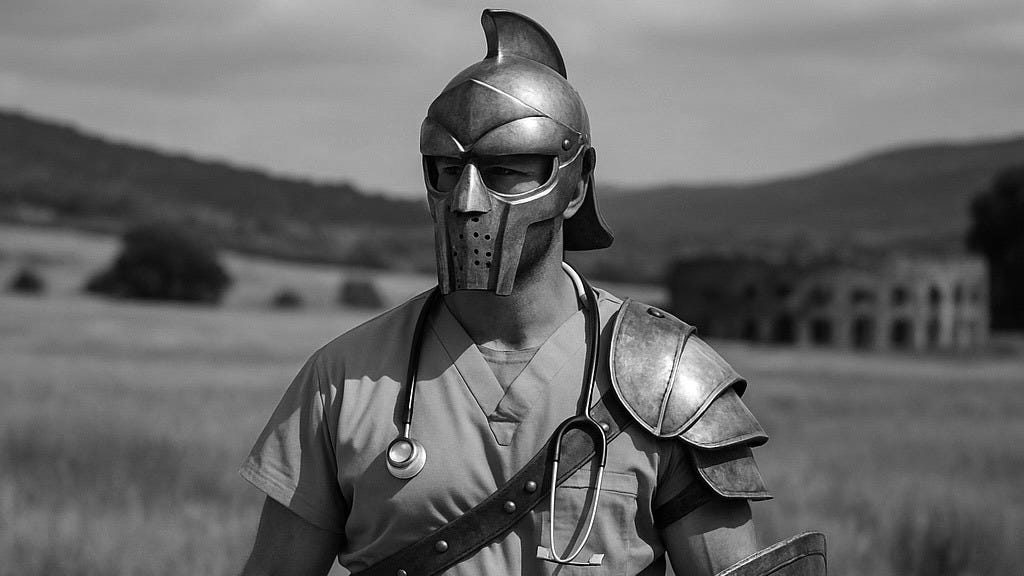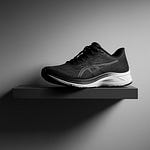“Dude, you have to try this. Really, she’s the best, I swear.”
Forty‑eight hours later, I was on a mat, eyes watering—part pain, part relief. What blindsided me were the unexpected challenges: relentless pressure wringing my muscles like a sponge, sharp jolts up my spine with each strike, and the sheer will it took to stay still while my body screamed for mercy.
Had I known, I might have hesitated.
Six brutal double‑fist hits on my back. “Finiiiished,” she whispered. And with that, my first‑ever no‑oil martial arts-like thai-bodywork session on my skinny doctor’s frame was over. I felt great—painful but great. I had to wince a little again once I paid, but I figured the short‑ and mid‑term effects were worth that pain, too.
I felt like a pirate with a wooden leg walking home, and my whole physique felt kind of off the next couple of days. It took me a while to realize, that this was actually how aligned and normal should feel. Two days later I felt awesome.
The athlete’s unfair advantage
Watching the Olympics or the FIFA World Cup, it’s obvious: high‑performing artists—masters of their field—are surrounded by professional supporters who keep their bodies, minds, and spirits at their best so they can give their best. Massage therapists, nutrition pros, stress managers, dieticians, prescribed rest plans—you name it.
But look at two top‑performing areas where this logic often breaks down: healthcare professionals and C‑suite executives.
For some reason, we accept that people who run around a field for 90 minutes chasing a ball need full‑stack support. Yet the people who run multi‑billion‑dollar companies—and people who literally have your health in their hands—are somehow expected to figure out elite performance solo, maybe with the occasional foot massage from a spouse.
We can complain about salaries and systems, but that won’t move us forward. What we can do is steal the gladiator mindset: a fierce, proactive approach to self‑preservation, where you treat your body and mind like the ultimate arena weapon and invest in them relentlessly to outlast and outperform.
We can acknowledge the investment, build our own support group, and share the nuggets of gold with each other. Looking back, consciously and subconsciously, that’s exactly what I did.
How I built my support team
Over the years, partly by design and partly by necessity, I assembled exactly the kind of high-level support network that elite athletes take for granted:
Structural care
A physiotherapist who regularly cracked my motion apparatus—spine and all—back into place after 6–8‑hour surgeries and long stretches in unnatural positions.
Recovery and bodywork
- A highly skilled Kalari Ayurvedic therapist for 72‑hour rejuvenation system reboots: herbal‑infused oil massages, sweat boxes, sinus clearance, and sense‑grounding food and environment.
- Massage therapists in every city I moved to. I spent a fortune on all of them—and I’m 100% sure I’m above where I’d be without them.
Nutrition and planning
Regular assessments of my diet and practical ideas to meal prep, including for crazy clinic days.
Mobility and mindset
Hundreds of hours in yoga classes and meditation retreats. Another fortune spent—and I’m 100% sure these are major reasons why I’m in better physical shape at 42 than at 22.
I don’t need epigenetic testing to see how much better off I am than many of my same‑aged colleagues. I quit smoking and drinking decades ago. I spend a large part of my salary on taking care of myself. I can complain that it had to be me who paid for it. At the end of the day, it’s me who has to live in this body. While it would be nice if someone else paid, I’m happy to do it myself.
And I’ve also seen the cost of not investing.
Stress‑induced psychosis that leaves a colleague found completely incapacitated, with their car inexplicably discovered burned out kilometers away—and neither they nor anyone else can remember what happened. Being admitted to your own ICU because of ignored diabetes. The extreme emotional and monetary costs of a failed marriage when you’ve prioritized everything except the relationship that matters most.
These aren’t abstract warnings. These are people I know. These are versions of myself I narrowly avoided becoming.
Where leaders fall behind
We normalize 14‑hour days, ignore ergonomics, and skip planned recovery. We treat ourselves like amateurs and then expect elite output.
You can’t perform like an elite athlete if you treat yourself like someone who just started.
So take an honest inventory:
Strip down and face the mirror. Look at your physique. Not with judgment—with curiosity. What does this body tell you about how you’ve been living?
Sit down, close your eyes, and scan inward. Feel where your body is tight or in pain. Notice what you’ve been ignoring.
Open your fridge and see what’s actually in there. Not the aspirational meal prep from three weeks ago—what you actually ate this week.
Ask yourself: Is this what you’d recommend to top performers if they asked for your professional advice?
If yes, congratulate yourself. You’re in the top 1%.
If not, don’t be hard on yourself. Nobody taught us this. We weren’t taught it in medical school, business school, or at any step in our careers. We have to learn it and take care of it ourselves.
The good news: it can be done. It’s not impossible. And while not everyone has equal resources, most of us have more capacity than we’re currently using.
Good / Better / Best: make it accessible
Not every season permits the “best” stack, and not everyone starts from the same place. The goal is progress, not perfection. Small, consistent upgrades compound dramatically over time.
Good (low cost, low time commitment)
- 10 minutes of daily mobility work—even just a simple down-dog or a basic stretching routine
- Evening screens‑off wind‑down starting 30–60 minutes before bed
- Sunday meal prep for 2–3 weeknights so you’re not choosing between skipping meals and drive-through at 9 PM
Better (moderate investment)
- Monthly bodywork session—massage, chiropractic, or whatever modality works for your body
- Dietitian consultation once per quarter to reality-check your nutrition against your actual schedule
- Basic sleep protocol: caffeine cutoff by 2 PM, light management - dimming lights after sunset, blackout curtains - consistent bedtime within a 30-minute window
Best (full stack)
- Integrated care plan with 2–3 key providers who communicate and adjust based on your specific demands
- Quarterly assessments and metrics—sleep quality, HRV, regular relevant lab work based on your health picture
- One to two immersive recovery retreats per year—whether that’s a meditation retreat, an ayurvedic panchakarma, a structured wellness program, or simply a week with zero connectivity and plenty of movement
A note on access: Not everyone can afford everything, and financial or time constraints are real. Start where you are. A free YouTube mobility routine done consistently will outperform an expensive program you never use. The key is to stop treating professional support as indulgent and start treating it as essential infrastructure.
ROI you can feel
Pick your measures, but the trend lines matter more than any single data point:
Physiological:
- Better sleep efficiency and steadier mood
- Lower resting heart rate and higher HRV
- Fewer overuse injuries and fewer sick days
Performance:
- More surgical stamina and clarity in hour six of a complex case
- Clearer decision‑making under pressure
- Consistent energy through afternoon meetings instead of the 3 PM crash
Relational:
- Actually present when you’re with your family, not just physically there while mentally reviewing the day
- Patience with your team when things go sideways
- Capacity to mentor junior colleagues instead of just surviving your own workload
Creative:
- Mental bandwidth at 8 PM to actually work on that project - that thing - instead of scrolling
- Saturday mornings where you wake up with energy to create, not just recover
- The cognitive space to think about your art, not just your to-do list
You probably didn’t sign up for The Renaissance Protocol just to optimize your quarterly reviews. You’re here because there’s a creative part of you that’s been on hold—maybe for years—and you want it back.
But here’s what nobody tells you: you can’t reclaim that dormant passion by just “making time for it.” That’s a very important first step. But your photography hobby doesn’t just need more calendar slots. It also needs you to not be physically depleted when those slots arrive.
Renaissance living isn’t about cramming creativity into an already maxed-out system. It’s about building the infrastructure that makes the full life—the one with both performance AND passion—actually sustainable.
The support team isn’t optional. It’s the foundation.
Start now
Pick one area where professional help could elevate you to an elite support level. Not three. Not “I’ll think about it.” One.
Research it this week. Find a provider, read reviews, ask colleagues who seem to have their act together.
Make an appointment now. Put it in your calendar before you close this email.
Protect one hour a week. Treat it like a board meeting or a surgical case—non-negotiable unless there’s a genuine emergency.
Iterate. After 4–6 weeks, assess what’s working and adjust. Add a second support pillar when the first becomes routine.
You didn’t hesitate to invest years and six figures into your professional training. Your body and mind are the platform that training runs on.
Thank me later.
Your support team isn’t just about performing better at work. It’s about having enough left over for the parts of life that make you feel alive. That’s what Renaissance living actually means.
To most from life
Nicco
-----
What’s one area where you need better support? Hit reply and let me know—I read every response, and I’m always collecting recommendations to share with the community.
Sing along to build your own army of support:












